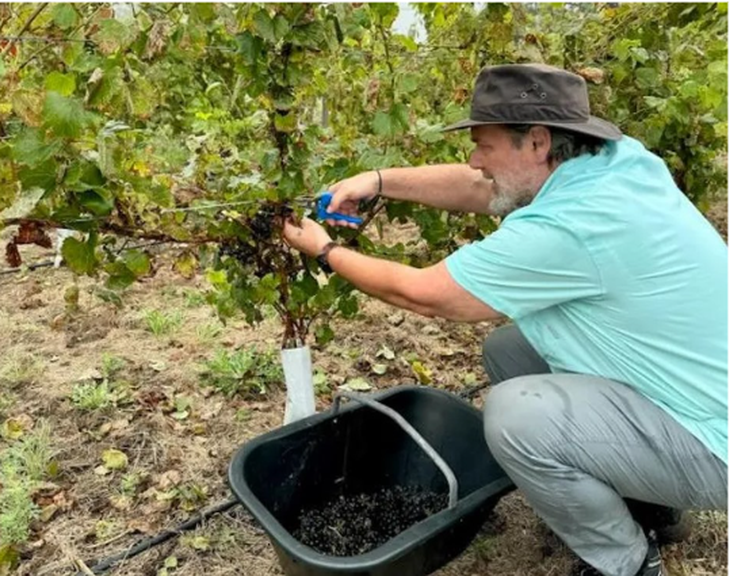Another case of a small vineyard in development is Kikela family business which aims to make it the first venture of its kind in Lauquen Train and to motivate other producers in the area to venture into this non-traditional activity in the area.
From asparagus to wines
“I always wanted to have a vineyard. When I graduated from university, I traveled to Mendoza to learn about an asparagus project in the Uco Valley. And although I wasn’t interested in asparagus., I came back from that trip delighted with the idea of betting on the vineyards“, commented Francisco “Pancho” Perkins, administrator of the family business.
Kikel is a member of the group CREATE August 30 Mari Lauquen (Western region). CREA is a non-profit civil association made up of 2,182 companies and directed by agricultural entrepreneurs who meet in groups to optimize the results of their organizations through the exchange of knowledge, ideas and experiences.
And this insertion had a lot to do with it for the start of the initiative, since the idea of a vineyard remained present for several years in Pancho Perkins’ head. The big obstacle was not being able to imagine wine production outside the Cuyo region.
But during a trip that Pancho made to Córdoba together with other members of his CREA group, he became convinced that this was possible: “I met a vineyard and its owner, without me asking him anything, said that grapes grow everywhere and he began to name different places in the world where vineyards are made, which are not necessarily in the mountains, such as in France, Italy and South Africa. He recalled that even in Argentina, The first vineyards were founded in Entre Ríos and not in Mendoza”.
“That’s where the chip fell on me. When I returned from Córdoba, I got together with my brothers and my mother, who are my partnersand I proposed to them the idea of making a vineyard. all my family said yesbut starting with a small project that would not put at risk the other activities carried out by the company,” he explained.
With that family agreement, Pancho traveled to Mendoza and contacted Alejandro Tossofourth generation of a family dedicated to wine production and member of CREA Los Andes. With him they went on a tour to see vineyards, wineries and winemakers.
Upon his return to Trenque Lauquen, he selected the place in the field where they installed the vineyard. Was on high and broken hillswhere weeping grass abounds and which contrasts with the rest of the surface of the establishment, dominated by the plains. These hills are characterized because they are sandy, with high infiltrationwhich allow adequate water management through irrigation.
“When we went up there it seemed like we were on the mountain”Perkins recalled.
In addition, the family analyzed how to integrate the vineyard activity with agricultural and livestock production. “From there I started thinking why not do it between the wheat, the sunflower, the soybeans and the cows”, he commented.
The stage of learning and paying the right to rent
PANCHO PERKINS WINERY BONAERENSE KIKEL.png
Francisco Pancho Perkins, one of the owners of the Kikel family business, in his vineyards.
“The biggest initial challenge was encouraging myself to do it. Because it is something completely different from everything we did. Somehow, Not having vineyards nearby challenged us to think different thingsbut at the same time we wanted to base ourselves on those who knew.”
Thus they received advice from professionals from Mendoza to set up the vineyards and In 2022 they planted the first hectare of grapeswith the aim of testing the techniques and learning, before carrying out the complete project, which would be completed with three hectares in production.
In that first stage, two white vines (Sauvignon blanc and Viognier) and four reds (Bonanda, Malbec, Cabernet sauvignon and Cabernet franc) were planted with trellis systems. In total, they estimate that they planted about 4,000 plants per hectare.
“The first year it was learning. We had a reasonable achievement for that first instance; We harvested few grapes, but we recorded more plant losses than we should have had. The frost caught us with plants that were too green and several of us died. That is, we pay the floor fee. That’s why we wanted to start small. Now we believe we learned a lot and this year we are encouraged to complete the project.”
In 2024 they planted the remaining two hectares to complete the venture, with the Malbec and Cabernet Franc strains.
“We think that Malbec It is the emblem grape from Argentina and, at the same time, we feel that Cabernet Franc It is the strain of the future. That’s why we’re playing for those grapes,” he said.
“In any case, once we have the plants we can make our own nursery and replenish the strains we want in a simple way,” he added.
By 2025 they hope to obtain a harvest, but the plants must wait a few more years to reach their full potential. “In any case, we already have well-formed plants and we calculate that We are going to have some harvest to start trying winemaking,” he said.
“The idea is to make wine ourselves. Originally we were thinking of sending the grapes to Mendoza, but the province does not allow the entry of the fruit, only the must. So We plan to make a micro winery to make wine directly in the fieldwho take very good care of the technology, the temperature at the time of fermentation, and work with the best products we can get. In principle, the idea is to put together a basic structure that will grow as production grows,” he explained.
A project to strengthen the ties of the family business
The project will reach its full potential in four or five yearswhen they expect to reach a production of 20,000 bottles of wine per year. However, it is a long term initiativewhich could extend over several decades and incorporate the next generations of the familyand that they can even add other ventures to the activity, such as tourism, gastronomy and hospitality.
“That is one of the things that motivated us and presents us with a different horizon, because with the crops of wheat, sunflower, corn, soybeans or peanuts, We only have to wait six months from when we sow until we harvest. On the other hand, the vineyard project It forces us to think in a completely different wayfive decades from now,” he explained.
“The idea is also generate local development. That’s why we have the gates open for anyone who wants to come see the vineyard. We share all the information, because we are also wanting that there are more projects of this guy,” Perkins said.
Perkins highlighted that although the intention is for the project to be profitable, they want the benefit to be capitalized. in cultural and emotional terms. On the one hand, the initiative aims to generate a sustainable and diverse plan, where the vineyard can be developed just 200 meters from an agricultural crop and 100 meters from the pasture where the cows graze, with efficient management.
On the other hand, he hopes that the initiative generate a strong bond in the familywhere not only the countryside unites them, but also art. “The vineyard project, which is equivalent to a minimum percentage within the company, It has a very great intangible value because it unites us as partners and family,” he concluded.
Source: Ambito
I am an author and journalist who has worked in the entertainment industry for over a decade. I currently work as a news editor at a major news website, and my focus is on covering the latest trends in entertainment. I also write occasional pieces for other outlets, and have authored two books about the entertainment industry.




